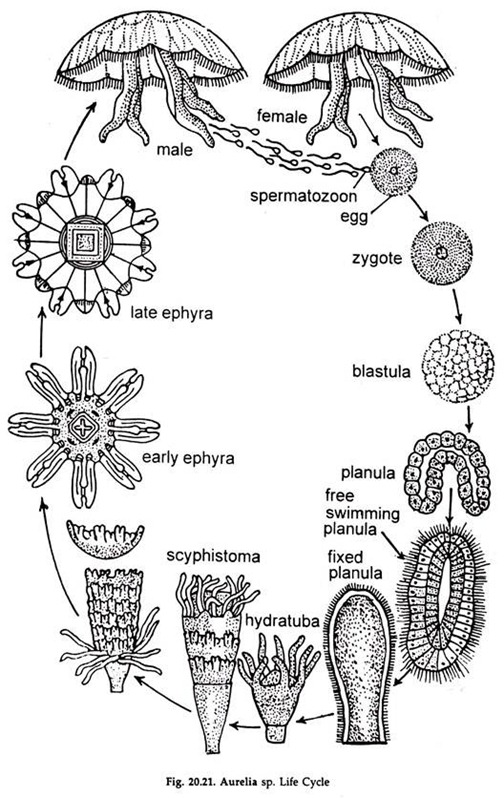In this article we will discuss about the life cycle of aurelia, explained with the help of a suitable diagram.
Reproduction in Aurelia:
The sexes are lodged in distinct individuals and. the four horseshoe-shaped gonads are either testes or ovaries. The spermatozoa or ova are shed in the stomach. The spermatozoa come to the exterior with water current and enter the stomach of a female individual with water current. Fertilization is internal.
Development and Life History of Aurelia (Fig. 20.21):
ADVERTISEMENTS:
i. The zygote divides regularly and a blastula is formed.
ii. By invagination of the blastula an oval, two-layered ciliated planula larva is formed, blastopore of which is not closed.
iii. After a brief period of free life, the larva settles down by the end opposite to the blastopore, loses its cilia and gradually transforms into a hydra tuba.
iv. A definite mouth is formed at the distal end.
ADVERTISEMENTS:
v. On the opposite side of the mouth two tentacles are formed by out-pushing. Soon two others appear at right angles to the first pair; then four, and subsequently eight more tentacles appear. The larva is now provided with sixteen tentacles arranged in a circlet.
vi. By this time, the proximal end narrows down to a stalk-like structure the stolon, and the distal end becomes expanded.
vii. Inter-radial in position, the endoderm of the gastric cavity is folded into four longitudinal ridges, the gastric ridges or taenioles.
viii. The mouth assumes a square shape and its sides are elevated to form a short manubrium.
ADVERTISEMENTS:
ix. The ectoderm of the region between the mouth and the circlet of tentacles becomes invaginated in four inter-radii to form four septal funnels or infundibula, which sink in the four gastric ridges.
x. The hydra-tuba feeds and produces new hydratubae by budding from its stolon throughout the summer. The buds may separate from the mother hydra-tuba. Budding ceases at the end of the summer.
xi. The hydra-tuba stage persists for a long period and undergoes strobilation or transverse fission in the next year.
xii. This stage of a scyphozoan polyp is known as scyphistoma larva, and it is about 1.25 cm in length.
xiii. Several transverse constrictions appear on the larva and, as the constrictions grow deeper, the larva appears like a pile of discs, one placed above the other.
xiv. The edge of each disc is provided with eight bifid arms bearing deep notches. As the constriction proceeds, the stomach becomes closed on the lower surface of each disc, while on the upper surface it remains open and its outer edges are transformed into a manubrium.
xv. Finally, the disc-like bodies separate form one another, turn upside down and are known as ephyra. Each ephyra carries with it a part of the stomach with the gastric ridges.
xvi. The mouth becomes elevated on the manubrium, tentaculocysts appear at the notches of the bifid arms, gastric filaments appear on the gastric ridges, soon followed by others and the stomach extends in the arms.
xvii. The swimming ephyra grows rapidly, notches are filled up and the umbrella becomes rounded; four oral arms and marginal tentacles appear and it is transformed into an adult Aurelia.
Alternation of Generations of Aurelia:
In a sense, an alternation of generations is present in the life history of Aurelia. The sexual generation is represented by the adult Aurelia, which is produced by asexual means from the scyphistoma larva and the scyphistoma is produced sexually from the adult Aurelia.
But unlike the budding of the hydrozoan polyp, the polyp undergoes several constrictions to produce a few adult individuals and it is not considered as a case of asexual generation.
The life history of Aurelia may better be described as a metamorphosis complicated by multiplication in the larval stage than a true alternation of generations. It has also been seen that, under certain conditions, direct development from egg to scyphistoma, and that to the adult Aurelia occurs without the intervention of the so- called asexual reproduction.
